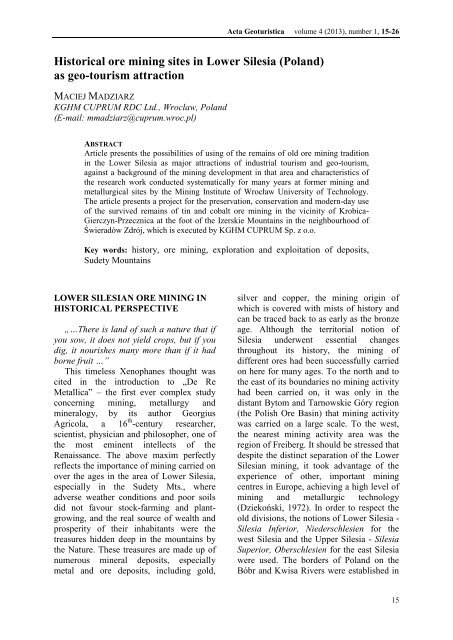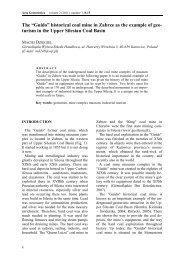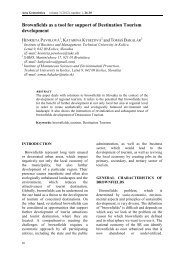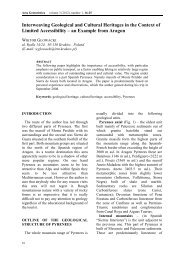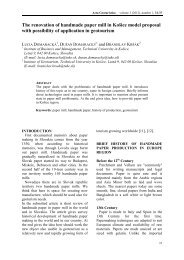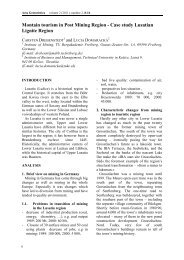Historical ore mining sites in Lower Silesia (Poland) - Acta Geoturistica
Historical ore mining sites in Lower Silesia (Poland) - Acta Geoturistica
Historical ore mining sites in Lower Silesia (Poland) - Acta Geoturistica
Create successful ePaper yourself
Turn your PDF publications into a flip-book with our unique Google optimized e-Paper software.
<strong>Acta</strong> <strong>Geoturistica</strong> volume 4 (2013), number 1, 15-26<strong>Historical</strong> <strong>ore</strong> <strong>m<strong>in</strong><strong>in</strong>g</strong> <strong>sites</strong> <strong>in</strong> <strong>Lower</strong> <strong>Silesia</strong> (<strong>Poland</strong>)as geo-tourism attractionMACIEJ MADZIARZKGHM CUPRUM RDC Ltd., Wroclaw, <strong>Poland</strong>(E-mail: mmadziarz@cuprum.wroc.pl)ABSTRACTArticle presents the possibilities of us<strong>in</strong>g of the rema<strong>in</strong>s of old <strong>ore</strong> <strong>m<strong>in</strong><strong>in</strong>g</strong> tradition<strong>in</strong> the <strong>Lower</strong> <strong>Silesia</strong> as major attractions of <strong>in</strong>dustrial tourism and geo-tourism,aga<strong>in</strong>st a background of the <strong>m<strong>in</strong><strong>in</strong>g</strong> development <strong>in</strong> that area and characteristics ofthe research work conducted systematically for many years at former <strong>m<strong>in</strong><strong>in</strong>g</strong> andmetallurgical <strong>sites</strong> by the M<strong>in</strong><strong>in</strong>g Institute of Wrocław University of Technology.The article presents a project for the preservation, conservation and modern-day useof the survived rema<strong>in</strong>s of t<strong>in</strong> and cobalt <strong>ore</strong> <strong>m<strong>in</strong><strong>in</strong>g</strong> <strong>in</strong> the vic<strong>in</strong>ity of Krobica-Gierczyn-Przecznica at the foot of the Izerskie Mounta<strong>in</strong>s <strong>in</strong> the neighbourhood ofŚwieradów Zdrój, which is executed by KGHM CUPRUM Sp. z o.o.Key words: history, <strong>ore</strong> <strong>m<strong>in</strong><strong>in</strong>g</strong>, exploration and exploitation of deposits,Sudety Mounta<strong>in</strong>sLOWER SILESIAN ORE MINING INHISTORICAL PERSPECTIVE„…There is land of such a nature that ifyou sow, it does not yield crops, but if youdig, it nourishes many m<strong>ore</strong> than if it hadborne fruit …”This timeless Xenophanes thought wascited <strong>in</strong> the <strong>in</strong>troduction to „De ReMetallica” – the first ever complex studyconcern<strong>in</strong>g <strong>m<strong>in</strong><strong>in</strong>g</strong>, metallurgy andm<strong>in</strong>eralogy, by its author GeorgiusAgricola, a 16 th -century researcher,scientist, physician and philosopher, one ofthe most em<strong>in</strong>ent <strong>in</strong>tellects of theRenaissance. The above maxim perfectlyreflects the importance of <strong>m<strong>in</strong><strong>in</strong>g</strong> carried onover the ages <strong>in</strong> the area of <strong>Lower</strong> <strong>Silesia</strong>,especially <strong>in</strong> the Sudety Mts., whereadverse weather conditions and poor soilsdid not favour stock-farm<strong>in</strong>g and plantgrow<strong>in</strong>g,and the real source of wealth andprosperity of their <strong>in</strong>habitants were thetreasures hidden deep <strong>in</strong> the mounta<strong>in</strong>s bythe Nature. These treasures are made up ofnumerous m<strong>in</strong>eral deposits, especiallymetal and <strong>ore</strong> deposits, <strong>in</strong>clud<strong>in</strong>g gold,silver and copper, the <strong>m<strong>in</strong><strong>in</strong>g</strong> orig<strong>in</strong> ofwhich is covered with mists of history andcan be traced back to as early as the bronzeage. Although the territorial notion of<strong>Silesia</strong> underwent essential changesthroughout its history, the <strong>m<strong>in</strong><strong>in</strong>g</strong> ofdifferent <strong>ore</strong>s had been successfully carriedon here for many ages. To the north and tothe east of its boundaries no <strong>m<strong>in</strong><strong>in</strong>g</strong> activityhad been carried on, it was only <strong>in</strong> thedistant Bytom and Tarnowskie Góry region(the Polish Ore Bas<strong>in</strong>) that <strong>m<strong>in</strong><strong>in</strong>g</strong> activitywas carried on a large scale. To the west,the nearest <strong>m<strong>in</strong><strong>in</strong>g</strong> activity area was theregion of Freiberg. It should be stressed thatdespite the dist<strong>in</strong>ct separation of the <strong>Lower</strong><strong>Silesia</strong>n <strong>m<strong>in</strong><strong>in</strong>g</strong>, it took advantage of theexperience of other, important <strong>m<strong>in</strong><strong>in</strong>g</strong>centres <strong>in</strong> Europe, achiev<strong>in</strong>g a high level of<strong>m<strong>in</strong><strong>in</strong>g</strong> and metallurgic technology(Dziekoński, 1972). In order to respect theold divisions, the notions of <strong>Lower</strong> <strong>Silesia</strong> -<strong>Silesia</strong> Inferior, Niederschlesien for thewest <strong>Silesia</strong> and the Upper <strong>Silesia</strong> - <strong>Silesia</strong>Superior, Oberschlesien for the east <strong>Silesia</strong>were used. The borders of <strong>Poland</strong> on theBóbr and Kwisa Rivers were established <strong>in</strong>15
<strong>Acta</strong> <strong>Geoturistica</strong> volume 4 (2013), number 1, 15-26the year of 1000, when the Wrocławbishopric was created and they did notundergo any major changes throughout theMiddle Ages. The south border constitutedthe massifs of the Sudety Mounta<strong>in</strong>s(Czapliński et. al., 2002). Despite thecomplex and turbulent political history ofthe <strong>Silesia</strong>, <strong>m<strong>in</strong><strong>in</strong>g</strong> activity has always animportant economic role, provid<strong>in</strong>glivelihood for their <strong>in</strong>habitants and forregional development opportunities. Theorig<strong>in</strong> of many <strong>Lower</strong> <strong>Silesia</strong>n places isassociated with <strong>m<strong>in</strong><strong>in</strong>g</strong>. Gold, <strong>ore</strong>s of silverand lead, copper, t<strong>in</strong>, arsenic, cobaltchromium, iron, coal, lignite, build<strong>in</strong>gstone, and even m<strong>in</strong>eral waters constitutedlarge resources of that region. However, thesubject of <strong>in</strong>terest for former m<strong>in</strong>ers were,first of all, numerous, small polymetallic<strong>ore</strong> deposits, usually conta<strong>in</strong><strong>in</strong>g a few basic<strong>ore</strong> m<strong>in</strong>erals, exploited <strong>in</strong> a documentedmanner over the period from the 13 th to 20 thcentury (Dziekoński, 1972). In <strong>Lower</strong><strong>Silesia</strong>, m<strong>ore</strong> precisely <strong>in</strong> the Sudety Mts.,these types of <strong>ore</strong> formations encompass anumber of deposits and occurrencescharacterised by multicomponent andvariable m<strong>in</strong>eralisation. The area of theiroccurrence is the Sudety Mts. and theirfoothills, where ve<strong>in</strong>s or m<strong>in</strong>eralised zonesreach the length of m<strong>ore</strong> than 2 km(Radzimowice), and the depth of m<strong>ore</strong> than300 m (Kowary) (Dziedzic et al., 1979). Inthe <strong>in</strong>itial <strong>m<strong>in</strong><strong>in</strong>g</strong> period, first of all therichest and easily available deposits atsmall depths have been exploited, and theve<strong>in</strong> deposits <strong>in</strong>itially evaluated as abundantoften turned out to be small and difficult <strong>in</strong>exploitation.<strong>Lower</strong> <strong>Silesia</strong> is divided <strong>in</strong>to six ma<strong>in</strong>regions <strong>in</strong> respect of the useful m<strong>in</strong>eraloccurrence These are: Kłodzko Land,Sowie Mounta<strong>in</strong>s along with the Wałbrzychregion, the foothills of the KarkonoszeMounta<strong>in</strong>s, exploited gold-dust deposits <strong>in</strong>the vic<strong>in</strong>ity of Lwówek, Złotoryja andLegnica, the so-called North-SudetenZechste<strong>in</strong> depression (hav<strong>in</strong>g outcropssouth of Lwówek and Złotoryja and nearGrodziec), and F<strong>ore</strong>-Sudeten Zechste<strong>in</strong>monocl<strong>in</strong>e situated north of Lub<strong>in</strong>(Dziekoński, 1972). The historically knowndeposits were exploited over many ages andthey were mostly the so-called “opendeposits”, i.e. the <strong>ore</strong> bodies of thosedeposits were at least partly exposed by theerosion surface, which allowed their earlydiscovery and extraction (Dziedzic et al.,1979).German scientists Cloos, Berg, Bederkeand Petrascheck were the first to undertakework aimed to systematise the <strong>in</strong>formationon <strong>Lower</strong> <strong>Silesia</strong> deposit occurrence andgenesis, <strong>in</strong> comb<strong>in</strong>ation with geological andstructural assumptions. In 1936, thecomprehensive study “Schlesien.Bodenschätze und Industrie“, conta<strong>in</strong><strong>in</strong>gthe evaluation of geological basis for thedevelopment of m<strong>in</strong>eral extraction andprocess<strong>in</strong>g with<strong>in</strong> the area of <strong>Lower</strong> <strong>Silesia</strong>,was completed by a group of Germanscientists and researchers of that period,such as O. Spangenberg, E. Bederke, O.Eisenkraut, I. Bartsch, L. Gäbler, F. Ilner,A. Metz<strong>in</strong>g, M. Morgeroth, E. Pralle, D.Rademacher, F.W. Siegert, H. S<strong>in</strong>nreich,W. Thust (Madziarz, 2009). S<strong>in</strong>ce 1945 thatwork has been <strong>in</strong>tensely cont<strong>in</strong>ued by thePolish researchers and it has resulted <strong>in</strong> thediscovery of a huge polymetallic deposit ofcopper and silver, and consequently <strong>in</strong> themodern-day boom <strong>in</strong> the <strong>ore</strong> <strong>m<strong>in</strong><strong>in</strong>g</strong> <strong>in</strong><strong>Lower</strong> <strong>Silesia</strong>. The deposits on the F<strong>ore</strong>-Sudeten monocl<strong>in</strong>e, which were discoveredonly after World War II, are ranked amongthe largest <strong>in</strong> the world and are nowadays<strong>in</strong>tensely exploited <strong>in</strong> the three modernunderground m<strong>in</strong>es.The history of <strong>Lower</strong> <strong>Silesia</strong>n <strong>ore</strong><strong>m<strong>in</strong><strong>in</strong>g</strong> is well known and mostlyassociated with the gold <strong>m<strong>in</strong><strong>in</strong>g</strong> which wascarried on <strong>in</strong> many centres and was ofspecial importance to them (Dziedzic et al.,1979; Dziekoński, 1972; Quir<strong>in</strong>g, 1948;Sachs, 1906). First of all, the area <strong>in</strong> theformer Legnica Duchy, between the riversKaczawa and Bóbr <strong>in</strong> the region ofLwówek, Złotoryja, Mikołajowice andBolesławiec was dist<strong>in</strong>guished by thevolume of production. The boom <strong>in</strong> gold16
<strong>Acta</strong> <strong>Geoturistica</strong> volume 4 (2013), number 1, 15-26<strong>m<strong>in</strong><strong>in</strong>g</strong> took place <strong>in</strong> the years 1180–1241,and only <strong>in</strong> the first half of the 13 th centurythe <strong>m<strong>in</strong><strong>in</strong>g</strong> law was <strong>in</strong>troduced for the goldm<strong>in</strong>es as one of the earliest <strong>in</strong> Europe(Lwówek <strong>in</strong> 1278, Złotoryja <strong>in</strong> 1342). Onthe European scale, Złoty Stok became arecognised centre of gold <strong>m<strong>in</strong><strong>in</strong>g</strong> andmetallurgy, where the arsenic <strong>ore</strong> depositsconta<strong>in</strong><strong>in</strong>g gold were exploited. There, thebeg<strong>in</strong>n<strong>in</strong>gs of <strong>m<strong>in</strong><strong>in</strong>g</strong> goes back to 1291,and the largest boom is traced back to 15 thcentury and the first half of the 16 th century.Till the end of the 17 th century the goal ofthe <strong>m<strong>in</strong><strong>in</strong>g</strong> activity was the production ofgold, and s<strong>in</strong>ce the beg<strong>in</strong>n<strong>in</strong>g of the 18 thcentury the activity had been concentratedon the production of arsenic, with goldbe<strong>in</strong>g recovered as a by-product. Theexploitation <strong>in</strong> Złoty Stock was f<strong>in</strong>allybrought to an end <strong>in</strong> 1962. Accord<strong>in</strong>g toGerman researcher Quir<strong>in</strong>g the name SowieMounta<strong>in</strong>s – <strong>in</strong> German: Eulengebirge,comes from the Celtic word mean<strong>in</strong>g gold(Quir<strong>in</strong>g, 1948). In fact, <strong>in</strong> the alreadyexploited<strong>ore</strong> ve<strong>in</strong>s <strong>in</strong> the Sowie Mounta<strong>in</strong>sthere were small amounts of that preciousmetal.Hidden beh<strong>in</strong>d the fasc<strong>in</strong>at<strong>in</strong>g sh<strong>in</strong>e ofgold is the forgotten but yet severalcentury-oldand noble history of <strong>Lower</strong><strong>Silesia</strong>n <strong>m<strong>in</strong><strong>in</strong>g</strong> and metallurgy of manyother <strong>ore</strong>s among which <strong>ore</strong>s of copper,lead and silver, t<strong>in</strong> and cobalt, arsenic, ironand, later, uranium were historically mostsignificant. It is worth stress<strong>in</strong>g that goldand copper - the earliest used and m<strong>in</strong>edmetals by human be<strong>in</strong>g (Craig et al., 2003)were fairly abundant <strong>in</strong> relatively easy tof<strong>in</strong>d polymetallic ve<strong>in</strong> deposits <strong>in</strong> the areaof <strong>Lower</strong> <strong>Silesia</strong>, which can <strong>in</strong>dicate veryearly beg<strong>in</strong>n<strong>in</strong>gs of their exploitation <strong>in</strong> thatarea. Although as yet there is no materialevidence that the history of <strong>Lower</strong> <strong>Silesia</strong>n<strong>ore</strong> <strong>m<strong>in</strong><strong>in</strong>g</strong> goes back m<strong>ore</strong> than onethousand years, there is no way not to recallhere aga<strong>in</strong> the works of German scientist H.Quir<strong>in</strong>g, who l<strong>in</strong>ked the beg<strong>in</strong>n<strong>in</strong>gs of<strong>m<strong>in</strong><strong>in</strong>g</strong> works <strong>in</strong> the Sudeten with theactivity of Cretans – already around 2thousand years B.C., and their cont<strong>in</strong>uationwith the <strong>in</strong>fluence of Celts, who stayed <strong>in</strong>the <strong>Silesia</strong> <strong>in</strong> the period of the 4 th to 3 rdcentury B.C. (Celtic silver and bronze co<strong>in</strong>sare known). It is also known that <strong>in</strong> theperiod of the so-called “Lusatian Culture”,<strong>in</strong> the neighbourhood of Legnica andZłotoryja arms and tools were locally madeof bronze – an alloy of copper and t<strong>in</strong>, bycast<strong>in</strong>g <strong>in</strong> stone moulds, with the shortagesreplenished with imports from Carpathiansand Eastern Alps. In the bronze age thisarea was with<strong>in</strong> the reach of the so-called“Unietic Culture”, which formed fromaround 2100 B.C., especially south ofWrocław. Numerous copper products aswell as those made of bronze and gold,<strong>in</strong>clud<strong>in</strong>g arms, daily necessities,ornaments, etc. are found <strong>in</strong> the discoveredskeleton graveyards of that culture. It isknown that its twilight occurred as a resultof the fall of already-exist<strong>in</strong>g copper <strong>m<strong>in</strong><strong>in</strong>g</strong>and process<strong>in</strong>g centres, which were located<strong>in</strong> the areas where that culture evolved(Czapliński et. al., 2002). The documentedhistory of copper <strong>ore</strong> <strong>m<strong>in</strong><strong>in</strong>g</strong> <strong>in</strong> <strong>Lower</strong><strong>Silesia</strong> – the metal which, besides gold, wasthe earliest and <strong>in</strong>itially most extensivelyused one <strong>in</strong> the human history, both <strong>in</strong>ancient times and nowadays, encompassesthe period of at least 700 years, as the firstsurvived <strong>in</strong>formation on the existence of“Cuprifod<strong>in</strong>a <strong>in</strong> montibus” – which simplymeans „a copper m<strong>in</strong>e <strong>in</strong> the mounta<strong>in</strong>s” <strong>in</strong>Lat<strong>in</strong> (Dziekoński, 1972; Madziarz, 2010),<strong>in</strong> the vic<strong>in</strong>ity of Miedzianka near JeleniaGóra, comes from the year of 1311. Thecopper and arsenic <strong>ore</strong> deposits <strong>in</strong> the areaof northern Karkonosze Mts., <strong>in</strong> the vic<strong>in</strong>ityof Miedzianka i Ciechanowice,Radzimowice and Czarnów have anessential role <strong>in</strong> the development of <strong>m<strong>in</strong><strong>in</strong>g</strong><strong>in</strong> <strong>Lower</strong> <strong>Silesia</strong>. The second area <strong>in</strong> <strong>Lower</strong><strong>Silesia</strong>, where copper <strong>m<strong>in</strong><strong>in</strong>g</strong> activity wascarried on was the neighbourghood ofZłotoryja, where already <strong>in</strong> the 18 th century<strong>in</strong> the place called Leszczyna a copper <strong>ore</strong>m<strong>in</strong>e of sedimentary orig<strong>in</strong> was started, <strong>in</strong>the form of cupriferous shales poor <strong>in</strong> metalbut ensur<strong>in</strong>g stable production. The gentlyand uniformly decl<strong>in</strong><strong>in</strong>g bed exploited there17
<strong>Acta</strong> <strong>Geoturistica</strong> volume 4 (2013), number 1, 15-26<strong>in</strong> the “Stilles Glück” m<strong>in</strong>e <strong>in</strong> the secondhalf of the 19 th century ensured thesmoothness and cont<strong>in</strong>uity of production(Dziekoński, 1972). M<strong>in</strong><strong>in</strong>g activity <strong>in</strong> theNorth Sudeten Zechste<strong>in</strong> depression wasresumed only <strong>in</strong> the thirties of the 20 thcentury, when the progress <strong>in</strong> <strong>m<strong>in</strong><strong>in</strong>g</strong>technology and the shift <strong>in</strong> global <strong>m<strong>in</strong><strong>in</strong>g</strong>towards m<strong>ore</strong> and m<strong>ore</strong> po<strong>ore</strong>r <strong>ore</strong>s madethe <strong>m<strong>in</strong><strong>in</strong>g</strong> of those merely 0.8-1.2% <strong>ore</strong>swith uniform m<strong>in</strong>eralisation cost-effective.It gave the orig<strong>in</strong> to the so-called “OldCopper Bas<strong>in</strong>”, operat<strong>in</strong>g until the n<strong>in</strong>etiesof the 20 th century, <strong>in</strong> the region ofZłotoryja and Bolesławiec. M<strong>in</strong><strong>in</strong>g activityaimed at obta<strong>in</strong><strong>in</strong>g copper <strong>ore</strong>s were alsocarried on <strong>in</strong> a number of other places. Theobject of exploration and exploitation <strong>in</strong> thearea of <strong>Lower</strong> <strong>Silesia</strong> were alsopolymetallic deposits conta<strong>in</strong><strong>in</strong>g silver.Poor deposits of t<strong>in</strong> <strong>ore</strong> occur on thenorthern slopes of the Izerskie Mts., <strong>in</strong> thevic<strong>in</strong>ity of Gierczyn and small amounts ofcobalt m<strong>in</strong>erals exist <strong>in</strong> theirneighbourghood, <strong>in</strong> Przecznica. The t<strong>in</strong> <strong>ore</strong>swere exploited <strong>in</strong> the 16 th and 17 th century,and the cobalt m<strong>in</strong>erals were exploited <strong>in</strong>the 18 th and 19 th century (Dziekoński, 1972;Madziarz, 2008, 2012; Madziarz et al.2006, 2008, 2012).The exploitation of iron <strong>ore</strong>s was alsocarried on <strong>in</strong> <strong>Lower</strong> <strong>Silesia</strong>. The region ofKowary and that of Janowa Góra wereabundant of easily accessible magnetite. InKowary, the iron <strong>ore</strong>s had been exploiteds<strong>in</strong>ce 1148. In the second half of the 19 thcentury, Stanisławów near Jawor became animportant centre for <strong>m<strong>in</strong><strong>in</strong>g</strong> that material.The <strong>m<strong>in</strong><strong>in</strong>g</strong> works on the Sudetendeposits, apart from few exceptions, werecarried on periodically. In the <strong>in</strong>itial stageof exploitation, the richest and most easilyaccessible deposit parts were extracted.They often <strong>in</strong>cluded ve<strong>in</strong> deposits, <strong>in</strong>itiallyevaluated as abundant but then turned out tobe small and difficult <strong>in</strong> exploitation, whichled to abandon<strong>in</strong>g of m<strong>in</strong>es. The <strong>m<strong>in</strong><strong>in</strong>g</strong>activity was <strong>in</strong>terrupted by wars, epidemics,population migrations or by fall<strong>in</strong>g pricesof raw materials. Over a long period, theknowledge about the Sudeten deposits waslimited to those already recognised dur<strong>in</strong>gthe <strong>m<strong>in</strong><strong>in</strong>g</strong> activity carried on throughoutthe centuries, <strong>in</strong> the shallow near-surfaceparts (Dziekoński, 1972).The documentary collection of theformer German Higher M<strong>in</strong><strong>in</strong>g Office <strong>in</strong>Wrocław (Oberbergamt zu Breslau, OBBBreslau) is a rich source of <strong>in</strong>formation onthe history of <strong>m<strong>in</strong><strong>in</strong>g</strong> <strong>in</strong> <strong>Lower</strong> <strong>Silesia</strong>, <strong>in</strong>which the especially rich materials comefrom the years of 1779–1852. The sourcepublications for historical studies are codesconta<strong>in</strong><strong>in</strong>g names, summaries and full textsof documents from old chronicles.Furtherm<strong>ore</strong>, the works by Festenberg,Ste<strong>in</strong>beck and Fechner conta<strong>in</strong> plenty of<strong>in</strong>formation. Among the works publishedafter 1945, the work by Dziekoński (1972)is of special importance as it is acomprehensive source of <strong>in</strong>formation on thehistory of <strong>Lower</strong> <strong>Silesia</strong>n <strong>ore</strong> <strong>m<strong>in</strong><strong>in</strong>g</strong>.REMAINS OF FORMER ACTIVITYNowadays, most of the formerly exploiteddeposits <strong>in</strong> the area of <strong>Lower</strong> <strong>Silesia</strong> haveonly of historical importance. Hundreds ofyears of the <strong>in</strong>tense <strong>m<strong>in</strong><strong>in</strong>g</strong> works leftnumerous traces <strong>in</strong> the area, still readabledespite the lapse of centuries. Inherentlandscape element which is characteristicespecially for the mounta<strong>in</strong>s is numerousrema<strong>in</strong>s of former <strong>m<strong>in</strong><strong>in</strong>g</strong> activity. Theyconstitute a precious source of knowledgeabout the development of deposit <strong>m<strong>in</strong><strong>in</strong>g</strong>technology, provid<strong>in</strong>g the evidence ofknowledge and skills of the generations ofm<strong>in</strong>ers connected over the centuries withthe area of <strong>Lower</strong> <strong>Silesia</strong>. These relicsoccur <strong>in</strong> the area mostly <strong>in</strong> the form ofclearly dist<strong>in</strong>guished heaps of waste rock,land subsidence, and often <strong>in</strong> the form ofpartly or fully survived undergroundwork<strong>in</strong>gs: shafts and adits, often <strong>in</strong> goodcondition, ru<strong>in</strong>s of m<strong>in</strong>e build<strong>in</strong>gs, <strong>ore</strong>process<strong>in</strong>g and concentrat<strong>in</strong>g equipment(e.g. stream water damm<strong>in</strong>g reservoirs).These objects are usually devoid of any18
<strong>Acta</strong> <strong>Geoturistica</strong> volume 4 (2013), number 1, 15-26protection or documentation. Many of thehitherto survived and accessible objectsdisappear from the landscape f<strong>ore</strong>ver, as aresult of modern-day construction workscarried on <strong>in</strong> their vic<strong>in</strong>ity, <strong>in</strong>correctliquidation - without consideration to thehistorical value of such objects, or fill<strong>in</strong>gthem for dozens of years now with all k<strong>in</strong>dof wastes, <strong>in</strong>clud<strong>in</strong>g hazardous. In theworks devoted to the history of <strong>Lower</strong><strong>Silesia</strong>n <strong>m<strong>in</strong><strong>in</strong>g</strong> the issue of preserv<strong>in</strong>g therelics of former activity and theirimportance - as a source of knowledgeabout the old <strong>m<strong>in</strong><strong>in</strong>g</strong> techniques, as well asthe necessity to properly preserve andconserve them, or even the possibilities ofus<strong>in</strong>g them today as tourist attractions, apartfrom few examples, practically have notbeen addressed. And yet the confrontationof <strong>in</strong>formation derived from archivematerials with that obta<strong>in</strong>ed dur<strong>in</strong>g the fieldwork can lead to the enrichment ofknowledge concern<strong>in</strong>g the history of<strong>m<strong>in</strong><strong>in</strong>g</strong> <strong>in</strong> <strong>Lower</strong> <strong>Silesia</strong>, and the “specificatmosphere” of old, underground work<strong>in</strong>gsconstitutes a great attraction for manypeople, which can be used to improve theattractiveness of presently forgotten anddecl<strong>in</strong>ed places connected with the old <strong>ore</strong><strong>m<strong>in</strong><strong>in</strong>g</strong>.Exploratory and documentary workconducted <strong>in</strong> the field reveals the traces ofmerely visible land subsidence mark<strong>in</strong>g theroutes of adits and galleries made at a smalldepth, or collapsed shafts, as well asperfectly survived work<strong>in</strong>gs, with thefragments of l<strong>in</strong><strong>in</strong>g, equipment, etc. Thereexist large stretches of land covered withneighbour<strong>in</strong>g rema<strong>in</strong>s of shallow shaftsused <strong>in</strong> underground <strong>m<strong>in</strong><strong>in</strong>g</strong> with the multishaftmethod (e.g. on the slopes of theOłowiane Mts. <strong>in</strong> the vic<strong>in</strong>ity ofCiechanowice), traces of trenches andshallow prospect<strong>in</strong>g shafts mark<strong>in</strong>g all theregions of former exploitation, naturallycollapsed or “spaced-out” adits outlets, butalso survived large complexes ofunderground work<strong>in</strong>gs, with clearlydist<strong>in</strong>guished f<strong>ore</strong>heads, exploratory adits,and often with exploitation chambers ofrelatively large sizes. In a number of former<strong>m<strong>in</strong><strong>in</strong>g</strong> centres there still exist, <strong>in</strong> variousdegree of preservation, channels supply<strong>in</strong>gwater from rivers and streams to theprocess<strong>in</strong>g equipment as well as waterdams, often <strong>in</strong> the form of reservoirslocated close to the drift outlet. The waterenergy constituted the basic source fordriv<strong>in</strong>g dra<strong>in</strong>age, hoist<strong>in</strong>g and process<strong>in</strong>gequipment <strong>in</strong> most of the former <strong>Lower</strong><strong>Silesia</strong>n <strong>ore</strong> m<strong>in</strong>es until the middle of the19 th century.MINING AND ARCHAEOLOGICALWORKConsider<strong>in</strong>g the abundance of relics of theformer exploitation <strong>in</strong> the area of <strong>Lower</strong><strong>Silesia</strong> and their undeniable historical andcognitive value <strong>in</strong> 1995 work aimed atsystematic catalogu<strong>in</strong>g and document<strong>in</strong>g odsuch type of objects was undertaken at theM<strong>in</strong><strong>in</strong>g Institute of Wrocław University ofTechnology. Because of the specialcharacter of work conducted at the objectsof historical value which should besubjected to preservation ma<strong>in</strong>tenance, theagreement on scientific cooperation wasconcluded <strong>in</strong> 2006 between the Faculty ofGeoeng<strong>in</strong>eer<strong>in</strong>g, M<strong>in</strong><strong>in</strong>g and Geology ofWrocław University of Technology, theInstitute of Archaeology and the Institute ofHistory of the University of Wrocław, withthe aim to jo<strong>in</strong>tly conduct work concern<strong>in</strong>gformer <strong>m<strong>in</strong><strong>in</strong>g</strong> <strong>sites</strong> <strong>in</strong> the area of South-West <strong>Poland</strong>, thus the <strong>m<strong>in</strong><strong>in</strong>g</strong> archaeologywork. The research and catalogu<strong>in</strong>g workhas been conducted at a number of former<strong>ore</strong> <strong>m<strong>in</strong><strong>in</strong>g</strong> centres, among which there arethose of most importance from theviewpo<strong>in</strong>t of the history of <strong>m<strong>in</strong><strong>in</strong>g</strong> works <strong>in</strong><strong>Lower</strong> <strong>Silesia</strong>, as well as those of smallerimportance but hav<strong>in</strong>g a documented multicenturyhistory of exploration andexploitation. Among the regions under thestudy are: the site of former copper andarsenic <strong>ore</strong> <strong>m<strong>in</strong><strong>in</strong>g</strong> <strong>in</strong> the vic<strong>in</strong>ity ofMiedzianka, Ciechanowice and JanowiceWielkie, polymetallic <strong>ore</strong>s <strong>in</strong> Radzimowice19
<strong>Acta</strong> <strong>Geoturistica</strong> volume 4 (2013), number 1, 15-26and Czarnów, t<strong>in</strong> and cobalt <strong>ore</strong>s <strong>in</strong>Gierczyn and Przecznica, chromite <strong>in</strong> theŚlęża Massif, iron and uranium <strong>in</strong> theregion of Kowary, iron <strong>in</strong> Stanisławów,lead and silver <strong>in</strong> Marc<strong>in</strong>ków, BystrzycaGórna and Modliszów.Each centre of former exploitation the<strong>m<strong>in</strong><strong>in</strong>g</strong> works were carried on periodicallywith<strong>in</strong> the space of several centuries. Withthe development of knowledge andtechnology, the previously abandonedwork<strong>in</strong>gs were revisited several times andthe depth of exploitation was cont<strong>in</strong>ually<strong>in</strong>creased with the aim to make use of thenewest achievements <strong>in</strong> <strong>m<strong>in</strong><strong>in</strong>g</strong> technologyand geological knowledge. The effect ofsuch type of activities is a large number offormer m<strong>in</strong>e work<strong>in</strong>gs and surface build<strong>in</strong>grema<strong>in</strong>s, often spread even with<strong>in</strong> a s<strong>in</strong>glecentre of former <strong>m<strong>in</strong><strong>in</strong>g</strong> works over a large,usually undulat<strong>in</strong>g area. Traces of formerworks are usually obliterated as a result ofdifferent k<strong>in</strong>d of works carried on afterabandon<strong>in</strong>g the <strong>m<strong>in</strong><strong>in</strong>g</strong> works, e.g. f<strong>ore</strong>stryworks. The precise study of a s<strong>in</strong>gle site,even without giv<strong>in</strong>g consideration tounderground work<strong>in</strong>gs is a long-term andarduous work requir<strong>in</strong>g the participation ofa team of experts, <strong>in</strong>clud<strong>in</strong>g <strong>m<strong>in</strong><strong>in</strong>g</strong>archaeologists. The identification andexam<strong>in</strong>ation of underground work<strong>in</strong>gsentail speleological works, and the access tothe <strong>in</strong>teriors of former m<strong>in</strong>es often requiresreopen<strong>in</strong>g of their outlets that had beenfilled up for hundreds of years. This type ofactivity <strong>in</strong>volves, which is obvious, thenecessity to make many formal and legalarrangements, to say noth<strong>in</strong>g about theconsiderable costs of its completion. Due tothe above reasons, most of the hithertocompleted research and catalogu<strong>in</strong>g workhas been limited to the superficialidentification of former <strong>m<strong>in</strong><strong>in</strong>g</strong> work <strong>sites</strong>and still accessible parts of work<strong>in</strong>gs.Due to the importance of the historical<strong>m<strong>in</strong><strong>in</strong>g</strong> centres, the scope and results ofcompleted research work, and what isparticularly important – the possibilities ofus<strong>in</strong>g them <strong>in</strong> <strong>in</strong>dustrial tourism and geotourism,the results of the work carried out<strong>in</strong> the operat<strong>in</strong>g area of former lead andsilver <strong>ore</strong> m<strong>in</strong>es <strong>in</strong> Bystrzyca Górna (SowieMts.) and those conducted <strong>in</strong> the historicalregion of t<strong>in</strong> and cobalt <strong>ore</strong> <strong>m<strong>in</strong><strong>in</strong>g</strong> <strong>in</strong>Gierczyn and Przecznica (Izerskie Mts.) arepresented below.FORMER LEAD AND SILVER OREMINING SITES IN BYSTRZYCAGÓRNA (SOWIE MOUNTAINS, INNEIGHBOURHOOD OF ŚWIDNICA)The area of the occurrence of quartzbariteve<strong>in</strong>s with polymetallicm<strong>in</strong>eralisation (ma<strong>in</strong>ly lead and silverm<strong>in</strong>erals) <strong>in</strong> the neighbourhood ofBystrzyca Górna <strong>in</strong> the Sowie Mounta<strong>in</strong>swas, with<strong>in</strong> the space of m<strong>ore</strong> than fivecenturies, subjected periodically to fairly<strong>in</strong>tense exploration and exploitation works(Madziarz, 2008). In the area formerlyknown as “Goldener Wald” (GoldenF<strong>ore</strong>st), and m<strong>ore</strong> precisely, <strong>in</strong> the areaknown as “Silber Wiese” (Silver Meadow)the follow<strong>in</strong>g m<strong>in</strong>es operated <strong>in</strong> achronological order: Segen Gottes,Christ<strong>in</strong>englück, Victor Friedrich,Wilhelm<strong>in</strong>e, Beathe and probably Berthe.Although the documented <strong>in</strong>formation onthe <strong>m<strong>in</strong><strong>in</strong>g</strong> works <strong>in</strong> the neighbourhood ofBystrzyca Górna concerns only the year of1539 (Dziekoński, 1972) it is no way not torule out the considerably earlier moment oftheir beg<strong>in</strong>n<strong>in</strong>g, the sign of which can bethe shape and size of the cross-section ofthe work<strong>in</strong>gs reopened dur<strong>in</strong>g the <strong>m<strong>in</strong><strong>in</strong>g</strong>and archaeological work. The first m<strong>in</strong>eoperat<strong>in</strong>g <strong>in</strong> the described region was SegenGottes, which was relatively large for theSowie Mounta<strong>in</strong>s’ conditions. As knownfrom the survived documents, while driv<strong>in</strong>gthe work<strong>in</strong>gs the traces of „old works” wereencountered, which was the sign ofconsiderably earlier time of start<strong>in</strong>g the<strong>m<strong>in</strong><strong>in</strong>g</strong> works on the deposit <strong>in</strong> the Widnamounta<strong>in</strong> (Dziekoński, 1972). Thedocumented attempt to resume theexploitation there was undertaken for thelast time <strong>in</strong> the year of 1844, <strong>in</strong> the m<strong>in</strong>e20
<strong>Acta</strong> <strong>Geoturistica</strong> volume 4 (2013), number 1, 15-26called Beathe, however, the <strong>m<strong>in</strong><strong>in</strong>g</strong> workswere stopped after a few years – probablybecause the deposit was depleted. The areaof the former m<strong>in</strong>es <strong>in</strong> the north part of theSowie Mounta<strong>in</strong>s, was revisited after the<strong>Lower</strong> <strong>Silesia</strong> had been reunited with<strong>Poland</strong>. The exploration works were<strong>in</strong>itially aimed to evaluate the prospects ofthe occurrence and extraction of uranium<strong>ore</strong>s, and then barite (Madziarz, 2008).Despite the numerous source materials,the proper identification of the m<strong>in</strong>ework<strong>in</strong>gs mentioned <strong>in</strong> the survivedliterature and historically operat<strong>in</strong>g <strong>in</strong> theregion of Bystrzyca Górna became possibleonly today ow<strong>in</strong>g to the <strong>m<strong>in</strong><strong>in</strong>g</strong>archaeology work carried out <strong>in</strong> the WidnaMounta<strong>in</strong> <strong>in</strong> the years 2006–2010. Inconsultation with the Institute ofArchaeology of the University of Wrocławand after obta<strong>in</strong><strong>in</strong>g the consent from theowner of that land – the State F<strong>ore</strong>sts, partof the work<strong>in</strong>gs of the Beathe m<strong>in</strong>e werereopened <strong>in</strong> 2008, first the so-called „upperadit” located on the highest level (fig. 1),then the 18 th -century lower adit (<strong>in</strong> 2009).The chart<strong>in</strong>g of the work<strong>in</strong>gs completed <strong>in</strong>comparison with the archive plans from thecollection of the former OBB Breslau madeit possible to prove that the exam<strong>in</strong>edBeathe m<strong>in</strong>e located <strong>in</strong> the Silber Wiese,made use of the ma<strong>in</strong> open<strong>in</strong>g-out head<strong>in</strong>gsof the m<strong>in</strong>es operat<strong>in</strong>g there <strong>in</strong> the previouscenturies, i.e.: Segen Gottes,Christ<strong>in</strong>englück, Victor Friedrich andWilhelm<strong>in</strong>e. In this way, it was possible toprove without any doubts that the locationand layout of the work<strong>in</strong>gs <strong>in</strong> the WidnaMounta<strong>in</strong> corresponds to the m<strong>in</strong>es knownfrom the literature and operat<strong>in</strong>g <strong>in</strong> that area<strong>in</strong> the period from the 16 th to 19 th century(Madziarz 2008).Fig. 1 <strong>Historical</strong> <strong>m<strong>in</strong><strong>in</strong>g</strong> works <strong>in</strong> Bystrzyca Górna21
<strong>Acta</strong> <strong>Geoturistica</strong> volume 4 (2013), number 1, 15-26After complet<strong>in</strong>g the chart<strong>in</strong>g andphotographic documentation the work<strong>in</strong>gswere preserved and filled up aga<strong>in</strong>. Thecomplex of work<strong>in</strong>gs of the former m<strong>in</strong>es <strong>in</strong>the neighbourhood of Bystrzyca is wide, ithas a great historical value and absolutelyrequires further research and catalogu<strong>in</strong>gwork, as it constitutes an example of the<strong>m<strong>in</strong><strong>in</strong>g</strong> work development with<strong>in</strong> the spaceof about 500 years, and the condition of itswork<strong>in</strong>gs has not been impaired as a resultof exploration works for uranium <strong>ore</strong>s – asit was the case <strong>in</strong> many similar former <strong>ore</strong><strong>m<strong>in</strong><strong>in</strong>g</strong> centres <strong>in</strong> <strong>Lower</strong> <strong>Silesia</strong>.Based on the work results the concept ofcreat<strong>in</strong>g a tourist path present<strong>in</strong>g theattractions of the Bystrzyca River valley,among which the special role should playthe relics of the former <strong>m<strong>in</strong><strong>in</strong>g</strong> works,<strong>in</strong>clud<strong>in</strong>g the complex of perfectlypreserved underground work<strong>in</strong>gs datedback to the period from the 16 th century tothe beg<strong>in</strong>n<strong>in</strong>g of the 19 th century has beendeveloped. The authorities of ŚwidnicaCommune are <strong>in</strong>terested <strong>in</strong> the study resultsand are <strong>in</strong> favour of mak<strong>in</strong>g the complex ofhistorical m<strong>in</strong>e work<strong>in</strong>gs <strong>in</strong> the WidnaMounta<strong>in</strong> available for the tourist traffic asan <strong>in</strong>dustrial tourism and geo-tourismattraction.FORMER TIN AND COBALT OREMINING SITES IN GIERCZYN ANDPRZECZNICA REGION (IZERSKIEMTS.)The beg<strong>in</strong>n<strong>in</strong>gs of <strong>m<strong>in</strong><strong>in</strong>g</strong> works <strong>in</strong> theregion of Gierczyn and Przecznica <strong>in</strong> theKamienicki Ridge of the Izerskie Mts. aretraced back to the 16 th century, when the t<strong>in</strong><strong>ore</strong> <strong>m<strong>in</strong><strong>in</strong>g</strong> and metallurgy reached theapogee there (Dziekoński, 1972). The<strong>m<strong>in</strong><strong>in</strong>g</strong> works were stopped <strong>in</strong> time of theThirty Years’ War (1618-1648), there wereseveral attempts of their resumption, butthey were not successful. The explorationand exploitation works were carried onuntil the beg<strong>in</strong>n<strong>in</strong>g of the 19 th century, andthey were f<strong>in</strong>ally stopped <strong>in</strong> 1815. Thegradual decrease <strong>in</strong> t<strong>in</strong> <strong>ore</strong> extraction at theend of the 18 th century <strong>in</strong> Gierczynconverged with the beg<strong>in</strong>n<strong>in</strong>gs ofexploitation of cobalt <strong>ore</strong>s <strong>in</strong> nearbyPrzecznica, provid<strong>in</strong>g the basic componentfor a very expensive cobalt pa<strong>in</strong>t. Theexploitation of cobalt <strong>ore</strong>s <strong>in</strong> Przecznica hasof great economic importance, s<strong>in</strong>ce itsupplied about 10% of the then Europeanproduction of that dye. The <strong>m<strong>in</strong><strong>in</strong>g</strong> andmetallurgical works <strong>in</strong> the Sct. Maria-Annam<strong>in</strong>e were carried on until the middle of the19 th century. The German authoritiesbecame <strong>in</strong>terested aga<strong>in</strong> <strong>in</strong> the abandonedwork<strong>in</strong>gs of the Reicher Trost andHundsrücken t<strong>in</strong> m<strong>in</strong>es <strong>in</strong> 1939, <strong>in</strong>connection with the war preparations. After1945 the area of the occurrence of t<strong>in</strong>deposits became the subject of long-termgeological exploration. On the basis ofdocumented resources, the “Initial projectfor the construction and exploitation of theGierczyn m<strong>in</strong>e” was completed <strong>in</strong> 1957,which was operat<strong>in</strong>g on the basis of theformer work<strong>in</strong>gs, with the <strong>m<strong>in</strong><strong>in</strong>g</strong> workslimited to the prospect<strong>in</strong>g works only. Theexploitation was never started because thedeposit was too poor (Madziarz, 2008;2009; 2012, Madziarz et al., 2008).Numerous <strong>m<strong>in</strong><strong>in</strong>g</strong> objects are the rema<strong>in</strong>sof the m<strong>ore</strong> than 400 years’ documentedhistory of <strong>m<strong>in</strong><strong>in</strong>g</strong> works <strong>in</strong> the regionKrobica – Gierczyn – Przecznica. Dur<strong>in</strong>gthe catalogu<strong>in</strong>g work carried out <strong>in</strong> theanalysed region, the complexes of m<strong>in</strong>esand their superficial <strong>in</strong>frastructure, whichare known from archive materials, havebeen found and identified. They <strong>in</strong>clude:Sct. Maria-Anna, Drei Brüder and FryderykWilhelm <strong>in</strong> Przecznica; Morgenröthe,Kupfer Zeche and Reicher Trost <strong>in</strong>Gierczyn, St. Carol and Hundsrücken <strong>in</strong>Kotl<strong>in</strong>a, St. Johanes and Leopold <strong>in</strong>Krobica. Special attention should be paid tothe rema<strong>in</strong>s of shafts of the former m<strong>in</strong>esReicher Trost and Hundsrücken, on thebasis of which the m<strong>in</strong>e Gierczyn wasdesigned <strong>in</strong> the post-war period (Madziarzet al., 2006; 2012). Due to their relativelygood condition, the complex of work<strong>in</strong>gs of22
<strong>Acta</strong> <strong>Geoturistica</strong> volume 4 (2013), number 1, 15-26the former m<strong>in</strong>e Sct. Johannes and the aditLeopold <strong>in</strong> Krobica as well as the aditFryderyk Wilhelm <strong>in</strong> Przecznica (Madziarzet al., 2008) seem to be very <strong>in</strong>terest<strong>in</strong>g <strong>in</strong>terms of their use as a tourist attractions.Also, part of the underground work<strong>in</strong>gs ofthe Sct. Maria-Anna m<strong>in</strong>e <strong>in</strong> Przecznica is<strong>in</strong> perfect condition. In the flooded shaft ofthat m<strong>in</strong>e there still may exist extremelyprecious from the historical po<strong>in</strong>t of viewrema<strong>in</strong>s of the orig<strong>in</strong>al water drive dra<strong>in</strong>ageequipment.The results of the conducted work havearoused <strong>in</strong>terest of the Mirsk Communeauthorities, <strong>in</strong> the area of which the rema<strong>in</strong>sof former m<strong>in</strong>es are located. After theproper preservation and preparation, theseobjects should add to an <strong>in</strong>crease <strong>in</strong> thetourist attractiveness of Mirsk Commune,and consequently br<strong>in</strong>g measurableeconomic and social benefits. This idea isFig. 2 Former t<strong>in</strong> and cobalt <strong>ore</strong> m<strong>in</strong>es (16 th to 19 th century)23
<strong>Acta</strong> <strong>Geoturistica</strong> volume 4 (2013), number 1, 15-26supported by the experience of similarprojects for the restoration of historicalpost-<strong>m<strong>in</strong><strong>in</strong>g</strong> objects and turn<strong>in</strong>g them <strong>in</strong>totourist attractions <strong>in</strong> <strong>Poland</strong> and Europe. Asa result of the undertaken activities theproject entitled “Reclamation of the regionsdegraded by <strong>m<strong>in</strong><strong>in</strong>g</strong> activity <strong>in</strong> the area ofMirsk Commune, with the creation of atourist path Along the footpr<strong>in</strong>ts of old <strong>ore</strong><strong>m<strong>in</strong><strong>in</strong>g</strong>” (Madziarz et al., 2008). The projectwill be executed by KGHM CuprumResearch and Development Centre <strong>in</strong>Wrocław. It will be f<strong>in</strong>anced by MirskCommune from the European Unionresources, with<strong>in</strong> the framework of theRegional Operat<strong>in</strong>g Programme for the<strong>Lower</strong> <strong>Silesia</strong>n voivodeship for the years2007–2013. With<strong>in</strong> the framework of theabove-mentioned project, the complexreclamation of the former <strong>m<strong>in</strong><strong>in</strong>g</strong> <strong>sites</strong> <strong>in</strong>the area of Krobica – Gierczyn – Przecznicawill be carried out (towards the f<strong>ore</strong>st andtourism direction) and the tourist andeducational path (about 8 km long)present<strong>in</strong>g the history and rema<strong>in</strong>s of theformer t<strong>in</strong> and cobalt <strong>m<strong>in</strong><strong>in</strong>g</strong> <strong>in</strong> that areawill be created. After remov<strong>in</strong>g the wastesthe proper reclamation and managementwork will be carried out at the post-<strong>m<strong>in</strong><strong>in</strong>g</strong>objects, <strong>in</strong> the scope result<strong>in</strong>g from theplanned method of their management forthe tourist traffic needs. The ma<strong>in</strong>assumption adopted for the areamanagement design and creation of thetourist and teach<strong>in</strong>g path is the leastpossible <strong>in</strong>terference <strong>in</strong> the exist<strong>in</strong>gcondition of the former <strong>m<strong>in</strong><strong>in</strong>g</strong> <strong>sites</strong> and thesurround<strong>in</strong>g area. The ma<strong>in</strong> goal is to makethe rema<strong>in</strong>s of former <strong>m<strong>in</strong><strong>in</strong>g</strong> worksavailable to visitors <strong>in</strong> the condition asclose to the orig<strong>in</strong>al, i.e. <strong>in</strong> the period from16 th to 19 th century, as possible.The most important element of theplanned path “Along the footpr<strong>in</strong>ts of old<strong>ore</strong> <strong>m<strong>in</strong><strong>in</strong>g</strong>” will be the underground touristroute St. John’s M<strong>in</strong>e <strong>in</strong> Krobica (fig. 2),be<strong>in</strong>g prepared on the basis of historicalwork<strong>in</strong>gs from the years 1576–1816.Tourists, under the care of guides, willcover the distance of about 350 m along thework<strong>in</strong>gs from the period of the 16 th to 19 thcentury. This project, <strong>in</strong> its programmeassumptions, features the values qualify<strong>in</strong>git to the category of environmentallyorientedand socially-oriented projects. Thecompletion of the two basic task of theproject – clean<strong>in</strong>g the objects and post<strong>m<strong>in</strong><strong>in</strong>g</strong>area from different types of waste,and then carry<strong>in</strong>g out the reclamation andmanagement work, will br<strong>in</strong>g about aconsiderable improvement of theenvironment condition with<strong>in</strong> the area ofthe three villages: Krobica, Gierczyn andPrzecznica <strong>in</strong> Mirsk Commune. Therevitalisation of the environment,preservation and exhibition of the old<strong>m<strong>in</strong><strong>in</strong>g</strong> <strong>sites</strong> and, on their basis, creation ofthe tourist path with an attractiveunderground section should contribute tothe <strong>in</strong>crease <strong>in</strong> tourist traffic <strong>in</strong> the region ofthe above-mentioned commune. It willcerta<strong>in</strong>ly have a positive impact on theeconomic development of that region.CONCLUSIONAs a result of the research andcatalogu<strong>in</strong>g work concern<strong>in</strong>g the former <strong>ore</strong><strong>m<strong>in</strong><strong>in</strong>g</strong> <strong>in</strong> <strong>Lower</strong> <strong>Silesia</strong>, a number ofhistorical <strong>m<strong>in</strong><strong>in</strong>g</strong> <strong>sites</strong> hitherto knownma<strong>in</strong>ly from the source materials andhistorical studies have been identified,where the exploration and catalogu<strong>in</strong>g workwas conducted for the last time mostly atthe turn of the 40s and 50s of the 20 thcentury, <strong>in</strong> connection with the search foruranium <strong>ore</strong>s (Ocena, 1959). In order toexchange experience <strong>in</strong> the scope ofidentification and documentation of suchtype of objects as well as to spread theresults of the conducted work, theconference “M<strong>in</strong><strong>in</strong>g heritage and historyand mak<strong>in</strong>g use of rema<strong>in</strong>s of former<strong>m<strong>in</strong><strong>in</strong>g</strong> works” is organised every year,start<strong>in</strong>g from 2005. However, the mostimportant effect of the conducted workseems to be the practical use of their results,as the preparation basis for the recentproject executed by KGHM Cuprum24
<strong>Acta</strong> <strong>Geoturistica</strong> volume 4 (2013), number 1, 15-26company, under the title “Reclamation ofthe regions degraded by <strong>m<strong>in</strong><strong>in</strong>g</strong> activity <strong>in</strong>the area of Mirsk Commune with thecreation of the tourist path Along thefootpr<strong>in</strong>ts of old <strong>ore</strong> <strong>m<strong>in</strong><strong>in</strong>g</strong>”. This projectis a example of how to make use ofscientific and research work that isconducted by the scientific centre -Wrocław University of Technology, theresults of which have turned out to be<strong>in</strong>terest<strong>in</strong>g for practical po<strong>in</strong>t of view andbecome the subject of <strong>in</strong>terest of the selfgovernmentbodies due to the expectedbenefits associated with the improvement ofthe environment condition and developmentof the Commune. It is worth stress<strong>in</strong>g thatMirsk Commune representatives wereacqua<strong>in</strong>ted with the results of the researchand catalogu<strong>in</strong>g work dur<strong>in</strong>g the conference“M<strong>in</strong><strong>in</strong>g heritage and history and mak<strong>in</strong>guse of rema<strong>in</strong>s of former <strong>m<strong>in</strong><strong>in</strong>g</strong> works”,which entailed their <strong>in</strong>terest <strong>in</strong> the scope ofthe possibilities to make use of the <strong>m<strong>in</strong><strong>in</strong>g</strong>heritage survived <strong>in</strong> the area of theCommune <strong>in</strong> the development of <strong>in</strong>dustrialtourism and geo-tourism, and hence tosignificantly improve the hitherto modesttourist proposal.In the conditions of <strong>Lower</strong> <strong>Silesia</strong>, theproject executed on the basis of thedescribed work is an <strong>in</strong>novative andpilot<strong>in</strong>g project. At the first, has been madean attempt to save the complex of historical<strong>m<strong>in</strong><strong>in</strong>g</strong> <strong>sites</strong> dated <strong>in</strong> the period from the16 th to 19 th century, which have beendestroyed s<strong>in</strong>ce the 50s of the 20 th century,when the exploration works were f<strong>in</strong>allystopped there, and the former work<strong>in</strong>gshave become illegal waste dumps. The<strong>in</strong>terest aroused by the described<strong>in</strong>terdiscipl<strong>in</strong>ary project among the selfgovernmentof some <strong>Lower</strong> <strong>Silesia</strong>ncommunes <strong>in</strong> the area of which similarrema<strong>in</strong>s of former <strong>m<strong>in</strong><strong>in</strong>g</strong> works are locatedand <strong>in</strong> the community of people widelyassociated with tourism – both thoseconduct<strong>in</strong>g economic activity and thosemak<strong>in</strong>g use of attractions prepared forvisit<strong>in</strong>g. The rema<strong>in</strong>s of several-century-old<strong>m<strong>in</strong><strong>in</strong>g</strong> activity, properly preserved andmade available for visitors, may soonbecome the major tourist attraction of<strong>Lower</strong> <strong>Silesia</strong>.REFERENCESCRAIG J.R., VAUGHAN D.J., SKINNER B.J.,Zasoby Ziemi, Warszawa 2003.CZAPLIŃSKI M., KASZUBA E., WĄS G.,ŻERELIK R. (eds), Historia Śląska, Wyd.Uniw. Wroc., 2002.DZIEDZIC K., KOZŁOWSKI S.,MAJEROWICZ A., SAWICKI L. (eds),Surowce M<strong>in</strong>eralne Dolnego Śląska, Wrocław1979.DZIEKOŃSKI T., Wydobywanie i metalurgiakruszców na Dolnym Śląsku od XIII do połowyXX w., Wydawnictwo PAN, 1972.FESTENBERG-PACKISCH H., Der MetallischeBergbau Niederschlesiens, Wien 1881.MADZIARZ M., „Cuprifod<strong>in</strong>a <strong>in</strong> montibus” ohistorii i pozostałościach dawnych robótgórniczych w rejonie Miedzianki – miastazrodzonego i unicestwionego przez górnictwo,Dzieje Górnictwa – element europejskiegodziedzictwa kultury, vol. 3, Wrocław 2010.MADZIARZ M., Kopalnie „Czarnów”,„Miedzianka” i „Stara Góra” w poszukiwaniachokruszcowania uranowego oraz rud metali wlatach 40. i 50. XX w., Dzieje Górnictwa –element europejskiego dziedzictwa kultury, vol.2, Wrocław 2009.MADZIARZ M., Stan rozpoznania historycznieeksploatowanych sudeckich złóżpolimetalicznych w świetle wynikówpowojennych prac geologicznoposzukiwawczych,Prace Naukowe InstytutuGórnictwa PWr, No. 128, Series: Studia iMateriały No. 36, 2009.MADZIARZ M., Tereny dawnych robót górniczychw Bystrzycy Górnej, Modliszowie iDziećmorowicach w świetle danycharchiwalnych i badań współczesnych. (<strong>in</strong>:)Dzieje górnictwa – element europejskiegodziedzictwa kultury, Wrocław 2008.MADZIARZ M, Pozostałości dawnych kopalń rudkobaltu w rejonie Przecznicy, Dzieje Górnictwa -element europejskiego dziedzictwa kultury,Wrocław 2008.MADZIARZ M, Zadania i znaczenie sztolni whistorycznej eksploatacji górniczej na przykleizachowanych wyrobisk dawnego górnictwa rudcyny i kobaltu okolic Gierczyna, DziejeGórnictwa - element europejskiego dziedzictwakultury, Wrocław 2012.MADZIARZ M., MIZERA A., DĘBKOWSKI R.,Projekt „Rekultywacja obszarówzdegradowanych działalnością górniczą na25
<strong>Acta</strong> <strong>Geoturistica</strong> volume 4 (2013), number 1, 15-26terenie Gm<strong>in</strong>y Mirsk z utworzeniem ścieżkiŚladami dawnego górnictwa kruszców” jakokoncepcja kompleksowych działań w zakresieochrony i wykorzystania dziedzictwa górniczegoDolnego Śląska, Dzieje Górnictwa - elementeuropejskiego dziedzictwa kultury, Wrocław2012.MADZIARZ M, SZTUK H., Eksploatacja rudycyny w Górach Izerskich: historia czyperspektywa dla regionu?, Prace NaukoweInstytutu Górnictwa Politechniki WrocławskiejNr 117, Studia i Materiały No. 32, Wrocław2006.MADZIARZ M, SZTUK H., Kopalnia "Gierczyn"- zapomniany epizod w historii górnictwa rudZiem Zachodnich, Dzieje Górnictwa - elementeuropejskiego dziedzictwa kultury, Wrocław2008.NEY R. (red) Surowce M<strong>in</strong>eralne Polski, SurowceMetaliczne: miedź, srebro. WydawnictwoCentrum PPGSMiE PAN, Kraków 1997.PAULO A, STRZELSKA-SMAKOWSKA B.,Rudy metali nieżelaznych i szlachetnych,Kraków, Wyd. AGH, 2000.COLLECTIVE WORK, Ocena uranonośnościSudetów, Zakłady Przemysłowe R-1, Kowary,1959.COLLECTIVE WORK, Zarys Dziejów Górnictwana Ziemiach Polskich. Vol. I and II, Katowice1961.QUIRING H., Geschichte des Goldes, Stuttgart,1948.SACHS A., Bodenschätze Schlesiens. Erze, Kohlen,Nutzbare Geste<strong>in</strong>e, Leipzig 1906.26


